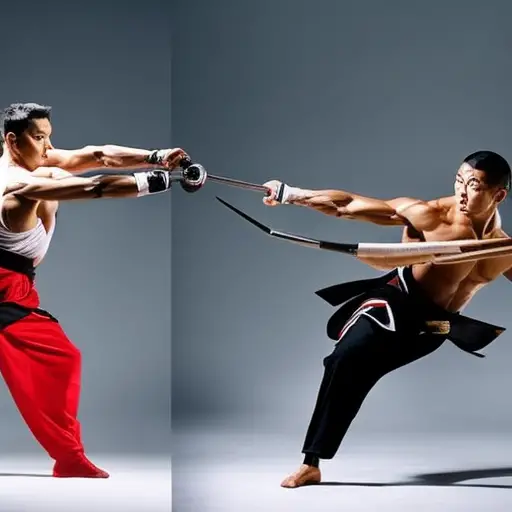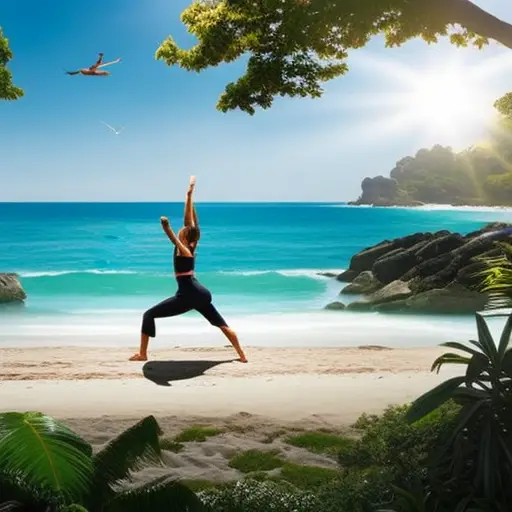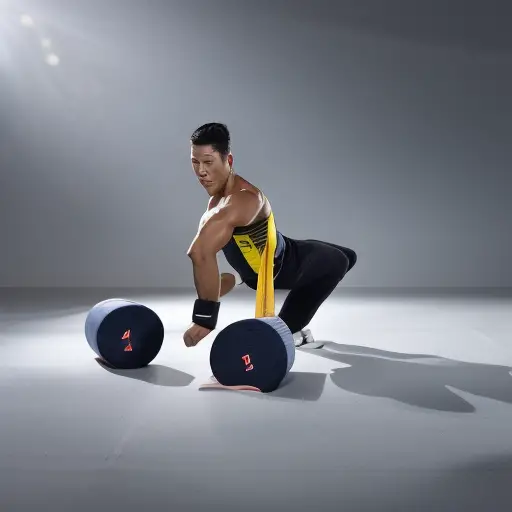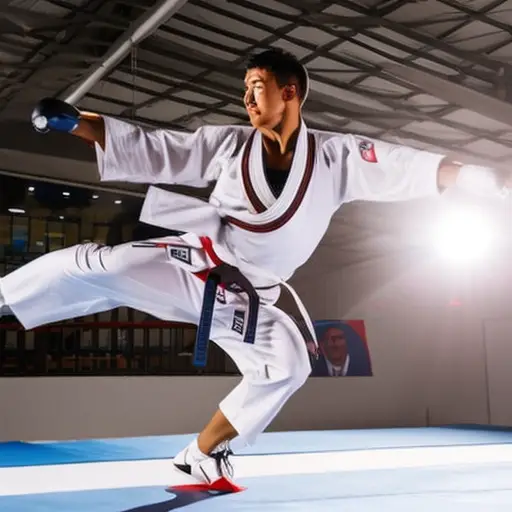Advanced Poomsae: Patterns for the Seasoned Practitioner

Master the intricacies of advanced poomsae patterns with our comprehensive guide.
From the evolution of poomsae to competition strategies, this article is designed for seasoned practitioners seeking to elevate their skills.
Delve into the complexity of advanced movements, perfect stances with precision and control, unleash power through dynamic kicks and strikes, and develop mental mastery for enhanced focus and concentration.
Gain the expertise needed to excel in advanced poomsae tournaments and become a true master of this traditional martial art.
The Evolution of Poomsae: From Beginner to Advanced
The gradual progression from basic to intricate poomsae routines is a crucial aspect of the evolution of one’s skill in taekwondo. As practitioners advance in their training, they are introduced to more complex and challenging poomsae techniques. This evolution allows them to refine their movements, enhance their flexibility and strength, and deepen their understanding of the art.
The evolution of poomsae techniques is a natural progression in taekwondo. Beginners start with simple patterns that focus on fundamental stances, strikes, and blocks. As they gain proficiency, they move on to more advanced sequences that incorporate intricate footwork, jumps, and spins. These advanced patterns demand a higher level of control, precision, and coordination.
Engaging in advanced poomsae training offers numerous benefits. Firstly, it improves physical fitness by enhancing strength, flexibility, and cardiovascular endurance. The intricate movements require practitioners to engage multiple muscle groups, resulting in a well-rounded workout. Secondly, it enhances mental focus and concentration. As practitioners strive to execute complex techniques with precision, they develop a heightened sense of awareness and mental clarity. Lastly, advanced poomsae training instills discipline and perseverance. The commitment to mastering intricate patterns fosters a strong work ethic and resilience, which can be applied to all aspects of life.
Unraveling the Complexity: Breaking Down Advanced Poomsae Movements
Complexity in advanced poomsae movements can be unraveled by analyzing the intricate combination of precise footwork, dynamic strikes, and fluid transitions. Breaking down advanced poomsae movements is essential for practitioners who aim to master complex stances and enhance their overall performance. Here are four key aspects to consider when unraveling the complexity of advanced poomsae movements:
-
Footwork: Advanced poomsae requires precise footwork, with each step carefully calculated and executed. Practitioners must focus on maintaining balance, proper weight distribution, and seamless transitions between stances.
-
Dynamic Strikes: Advanced poomsae movements often incorporate powerful strikes, such as punches and kicks. It is crucial to master the correct techniques, including the precise positioning of the striking limb, proper alignment, and effective follow-through.
-
Fluid Transitions: Fluidity and grace are vital in advanced poomsae. Practitioners must strive for seamless transitions between movements, emphasizing smoothness and continuity. This requires a deep understanding of the patterns and the ability to maintain control and balance throughout.
-
Mastering Complex Stances: Advanced poomsae often includes intricate stances that demand strength, flexibility, and stability. Practitioners should focus on perfecting these stances, understanding their purpose, and training to achieve proper alignment and balance.
Mastering the Art of Transitions: Seamless Flow in Advanced Poomsae
To achieve a seamless flow in advanced poomsae, practitioners must prioritize smooth transitions between movements while maintaining control and precision. Improving fluidity and achieving gracefulness are critical aspects of executing advanced poomsae patterns.
Fluidity refers to the ability to connect movements smoothly, without any interruptions or jerky motions. It requires practitioners to have a deep understanding of each movement and how it flows into the next. By practicing and perfecting each transition, practitioners can eliminate any pauses or hesitations, creating a seamless and continuous flow.
Incorporating smooth transitions in advanced poomsae is essential for achieving gracefulness. Gracefulness is about moving with elegance and poise, maintaining a sense of control and balance throughout the pattern. Smooth transitions contribute to the overall aesthetic appeal of the poomsae, enhancing the practitioner’s performance.
To improve fluidity and achieve gracefulness, practitioners must focus on several key elements. First, they must develop a strong sense of body awareness, understanding how their movements and weight shifts affect their balance and stability. They should also pay attention to their timing, ensuring that each movement seamlessly flows into the next without any pauses or rushed transitions. Additionally, practitioners should work on their flexibility and strength, as these physical attributes contribute to the smooth execution of movements.
Precision and Control: Perfecting Stances in Advanced Poomsae
Mastering complex stances is essential for advanced practitioners looking to enhance their poomsae performance. Precision and control in stances not only demonstrate a high level of skill, but also contribute to the overall fluidity and grace of the routine.
Mastering Complex Stances
Throughout the training journey of advanced poomsae practitioners, the process of refining and perfecting complex stances requires unwavering dedication and attention to detail. To master these stances, practitioners must focus on four key areas:
-
Balancing techniques: achieving stability in complex stances is crucial to executing poomsae movements with precision. Practitioners must learn how to distribute their weight evenly and maintain a strong center of gravity to avoid losing balance during transitions and movements.
-
Flexibility and mobility: improving range of motion in advanced stances is essential for executing the intricate movements required in poomsae. Regular stretching and mobility exercises help practitioners increase their flexibility, allowing them to perform deep stances and dynamic movements with ease.
-
Strength and control: advanced stances require a high level of strength and control. Practitioners must develop strong leg muscles and core stability to maintain the correct posture and execute movements with power and precision.
-
Body alignment and posture: precise body alignment and correct posture are fundamental in advanced poomsae. Practitioners must focus on aligning their hips, shoulders, and feet correctly to ensure optimal power and balance in their stances.
Enhancing Poomsae Performance
As practitioners progress in their advanced poomsae training, they can enhance their performance by focusing on precision and control, particularly in perfecting their stances. Improving technique in poomsae requires attention to detail and a deep understanding of proper stance execution. Here are some training tips to help practitioners refine their stances in advanced poomsae:
| Stance | Description | Training Tips |
|---|---|---|
| Front Stance | Feet hip-width apart, front knee bent, back leg straight | Maintain proper alignment of the knees, hips, and shoulders. Distribute weight evenly on both legs. |
| Horse Riding Stance | Feet wider than shoulder-width apart, knees bent, back straight | Keep the weight centered and avoid leaning forward or backward. Engage the core for stability. |
| Back Stance | Feet shoulder-width apart, one foot forward, knees bent | Ensure the front knee is directly above the ankle. Keep the back heel off the ground for balance. |
By perfecting these stances, practitioners can improve their technique and overall performance in advanced poomsae. With precision and control, they will be better prepared to unleash power through dynamic kicks and strikes, as we will explore in the subsequent section.
SUBSEQUENT SECTION TRANSITION:
Now that we have discussed enhancing poomsae performance through precision and control in stances, it is time to explore the next aspect of advanced poomsae – ‘unleashing power: dynamic kicks and strikes’.
Unleashing Power: Dynamic Kicks and Strikes in Advanced Poomsae
How can practitioners enhance their technique and maximize the power behind their kicks and strikes in advanced Poomsae?
Mastering dynamic kicks techniques and developing efficient power generation in strikes are essential for practitioners looking to elevate their performance in advanced Poomsae. Here are four key strategies to unleash power in your kicks and strikes:
-
Proper body alignment:
Maintaining a strong and balanced stance is crucial for generating power. Align your body correctly, ensuring that your hips, shoulders, and feet are in the right position. This alignment allows for maximum force transfer from the ground to your strikes. -
Hip rotation:
Utilize proper hip rotation to generate power and speed in your kicks and strikes. Engage your core muscles and initiate the movement from your hips, allowing for a more explosive and effective execution. -
Breath control:
Mastering breath control is essential for generating power. Coordinate your breathing with your movements, exhaling sharply at the point of impact. This release of air helps to engage the core muscles and increase the power behind your strikes. -
Speed and timing:
Develop speed and timing through consistent practice. Work on executing your techniques with precision and fluidity, focusing on speed and accuracy. This combination of speed and timing will amplify the power behind your kicks and strikes.
Mental Mastery: Developing Focus and Concentration in Advanced Poomsae
Developing focus and concentration are essential for achieving mental mastery in advanced Poomsae. As practitioners progress to higher levels, it becomes increasingly important to develop mental resilience and improve focus and concentration.
Advanced Poomsae requires precision, control, and the ability to execute complex movements with grace and accuracy. To attain this level of mastery, one must cultivate a strong mindset.
Developing mental resilience involves training the mind to remain calm and focused, regardless of external distractions or internal doubts. This can be achieved through various techniques such as meditation, visualization exercises, and mindfulness practices. By consistently practicing these techniques, practitioners can strengthen their ability to maintain concentration and stay present in the moment.
Improving focus and concentration requires discipline and dedication. It involves training the mind to eliminate distractions and fully engage in the present task at hand. This can be achieved through regular practice, where practitioners consciously direct their attention to each movement and transition in the Poomsae. By focusing on the details and intricacies of each technique, practitioners can refine their skills and enhance their overall performance.
Developing focus and concentration is not only crucial for mastering advanced Poomsae, but it also translates to other aspects of life. It cultivates mental discipline, enhances decision-making abilities, and promotes a sense of clarity and purpose. Through developing these mental attributes, practitioners can navigate advanced Poomsae tournaments with confidence and composure.
Transitioning into the subsequent section about ‘competition strategies: navigating advanced Poomsae tournaments’, practitioners who have developed mental mastery will have a distinct advantage. Their ability to maintain focus and concentration under pressure will allow them to perform at their best and adapt quickly to the demands of the competition.
Competition Strategies: Navigating Advanced Poomsae Tournaments
Successfully navigating advanced Poomsae tournaments requires strategic planning and precise execution to maximize performance. Here are four key strategies for competitors to consider in their competition preparation:
-
Familiarize Yourself with the Judging Criteria: Understanding the specific criteria that judges will be looking for is crucial. Take the time to study and practice the technical and artistic elements of each Poomsae pattern. This will help you tailor your performance to meet the judges’ expectations.
-
Develop a Consistent Training Plan: Consistency is key in advanced Poomsae training. Create a well-rounded training plan that includes regular practice of Poomsae patterns, strength and conditioning exercises, and flexibility training. This will help you build stamina, precision, and fluidity in your movements.
-
Focus on Execution and Presentation: In advanced Poomsae tournaments, flawless execution and confident presentation are essential. Work on perfecting each movement, paying attention to details such as timing, power, balance, and accuracy. Additionally, practice presenting your Poomsae with confidence, projecting your energy and charisma to engage the judges and audience.
-
Embrace Mental Preparation: Mental preparation is just as important as physical training. Develop strategies to stay calm, focused, and confident during the competition. Techniques such as visualization, positive self-talk, and deep breathing can help you control nerves and perform at your best.
Frequently Asked Questions
How Do I Choose the Right Poomsae Pattern for a Tournament?
When selecting a poomsae pattern for a tournament, it is important to consider factors such as your skill level, the requirements of the competition, and your personal strengths. This decision should be made strategically to maximize your chances of success.
What Are Some Common Mistakes to Avoid When Performing Advanced Poomsae Movements?
When performing advanced poomsae movements, it is crucial to avoid common mistakes that can hinder the execution of techniques. Focus on principles such as alignment, balance, timing, and breathing. Visualization, body awareness, and precision are important for fluidity and power. Strength, flexibility, speed, coordination, and rhythm play a significant role. A disciplined mindset, perseverance, and focus are essential for competition strategy and performance psychology. Mental training, goal setting, self-reflection, feedback, coaching, and a structured practice routine are key for improvement. Injury prevention, recovery, nutrition, and conditioning are crucial for maintaining optimal physical health.
How Can I Improve My Transitions Between Different Movements in Advanced Poomsae?
Improving timing and enhancing fluidity in transitions between movements is crucial in advanced poomsae. By focusing on proper body alignment, practicing precise footwork, and developing core strength, practitioners can achieve seamless and graceful transitions.
Are There Any Specific Exercises or Drills I Can Do to Improve My Stances in Advanced Poomsae?
To improve stances in advanced poomsae, incorporating specific exercises and drills is essential. These exercises can focus on strengthening the lower body, improving balance and stability, and enhancing flexibility, all of which contribute to achieving precise and powerful stances in poomsae performance.
How Can I Develop Mental Toughness and Concentration to Perform Well in Advanced Poomsae Competitions?
Developing mental fortitude and strategies for maintaining focus during competitions is crucial for performing well in advanced poomsae. Practicing mindfulness techniques, setting specific goals, and implementing visualization exercises can help enhance concentration and build mental toughness.
Conclusion
In conclusion, advanced poomsae is a journey that requires dedication, precision, and mental fortitude. It is a dance of intricate movements, seamless transitions, and powerful strikes.
Like a master painter creating a masterpiece, the seasoned practitioner must possess the knowledge, experience, and authority to execute each pattern with perfection.
Just as a symphony conductor leads an orchestra, the advanced poomsae practitioner must guide their body with precision and control.
With focus, concentration, and strategic planning, they can navigate the challenges of advanced poomsae tournaments.





